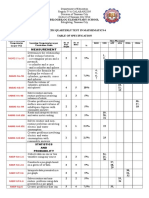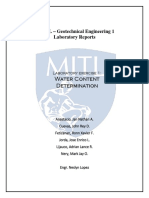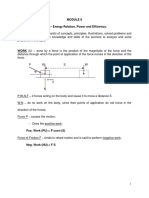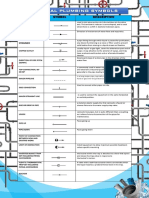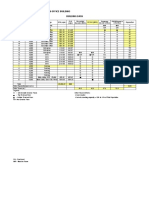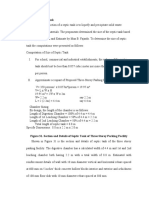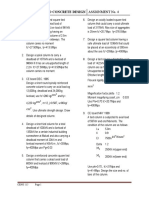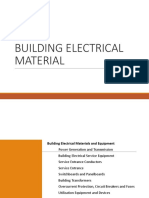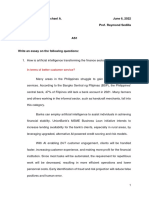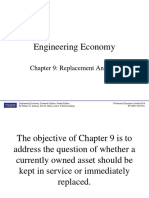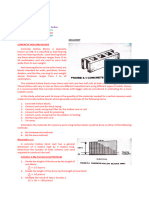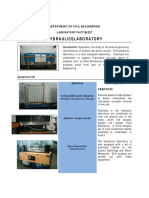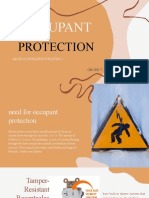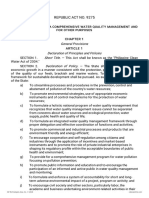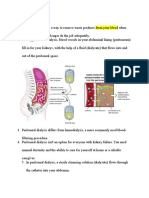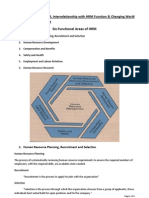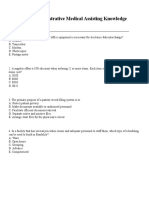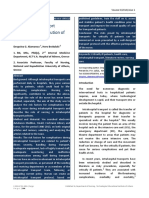0 ratings0% found this document useful (0 votes)
230 viewsEnv Engg
Env Engg
Uploaded by
Gem KrisnaThe document discusses the history and origins of environmental engineering and its focus on providing clean water and managing wastes. It then outlines several key Philippine environmental laws related to solid waste management, pollution control, clean air and water acts.
Copyright:
© All Rights Reserved
Available Formats
Download as DOCX, PDF, TXT or read online from Scribd
Env Engg
Env Engg
Uploaded by
Gem Krisna0 ratings0% found this document useful (0 votes)
230 views4 pagesThe document discusses the history and origins of environmental engineering and its focus on providing clean water and managing wastes. It then outlines several key Philippine environmental laws related to solid waste management, pollution control, clean air and water acts.
Original Description:
research paper
Original Title
env engg
Copyright
© © All Rights Reserved
Available Formats
DOCX, PDF, TXT or read online from Scribd
Share this document
Did you find this document useful?
Is this content inappropriate?
The document discusses the history and origins of environmental engineering and its focus on providing clean water and managing wastes. It then outlines several key Philippine environmental laws related to solid waste management, pollution control, clean air and water acts.
Copyright:
© All Rights Reserved
Available Formats
Download as DOCX, PDF, TXT or read online from Scribd
Download as docx, pdf, or txt
0 ratings0% found this document useful (0 votes)
230 views4 pagesEnv Engg
Env Engg
Uploaded by
Gem KrisnaThe document discusses the history and origins of environmental engineering and its focus on providing clean water and managing wastes. It then outlines several key Philippine environmental laws related to solid waste management, pollution control, clean air and water acts.
Copyright:
© All Rights Reserved
Available Formats
Download as DOCX, PDF, TXT or read online from Scribd
Download as docx, pdf, or txt
You are on page 1of 4
Introduction
Environmental engineering has a long history, although the phrase environmental
engineering is relatively new. The environment has different meanings in different
disciplines. In environmental engineering, the environment is where we live.
Environmental engineering is the application of science and engineering principles
to protect and utilize natural resources, control environmental pollution, improve
environmental quality to enable healthy ecosystems and comfortable habitation of
humans. It is based on multiple disciplines including geology, hydrology, biology,
chemistry, physics, medicine, engineering management, economics, laws, etc.
Environment engineering involves ecological framework of sustainable
management; government legislation, rules and regulation related to the
environment and waste management; and environmental management system.
The Origins of Environmental Engineering
The roots of environmental engineering reach back to the beginning of civilization.
Providing clean water and managing wastes became necessary whenever people
congregated in organized settlements. For ancient cities, the availability of a
dependable water source often meant the difference between survival and
destruction, and a water supply became a defensive necessity. The builders of wells
and aqueducts were the same people who were called on to build the city walls and
moats, as well as the catapults and other engines of war. These men became the
engineers of antiquity. It was not until the mid-1700s that engineers who built
facilities for the civilian population began to distinguish themselves from the
engineers primarily engaged in matters of warfare, and the term civil engineering
was born. In the formative years of the United States Military Academy, Civil
engineers the builders of roads, bridges, buildings, and railroads were called on
to design and construct water supplies for the cities, and to provide adequate
systems for the management of waterborne wastes and storm water.
The advent of industrialization brought with it unbelievably unsanitary conditions in
the cities because of the lack of water and waste management. There was no public
outcry, however, until it became evident that water could carry disease. From that
time on, civil engineers had to more than just provide an adequate supply of water;
they now had to make sure the water would not be a vector for disease
transmission. Public health became an integral concern of the civil engineers
entrusted with providing water supplies to the population centers, and the
elimination of waterborne disease became the major objective in the late 19 th
century. The civil engineers entrusted with the drainage of cities and the provision
of clean water supplies became public health engineers (in Britain) and sanitary
engineers (in the United States).
Philippine Environmental Laws
Ecological Solid Waste Management Act of 2000 (RA 9003). This law aims for the
reduction of solid waste through source reduction and waste minimization
measures, treatment and disposal of solid waste in accordance with ecologically
sustainable development principles. It also aims to ensure the proper segregation,
collection, transport, storage, treatment and disposal of solid waste through the
formulation and adoption of the best environmental practice in ecological waste
management excluding incineration. RA 9003 considers waste as a source that can
be recovered, emphasizing on recycling, reuse and composting as methods to
minimize waste problems. Three Rs of RA 9003 are reduce, recover and recycle.
The said act gives string emphasis on the role of municipal and local government
units (LGUs) providing for the crating of Solid Waste Management Communities up
to the barangay level. This requires the participation of nongovernment offices,
peoples organizations, church leaders, schools, businesses and community
organizations.
Types of Wastes According to Classification
Residual waste with no commercial value meant for disposal
Recycle waste that can be reused.
Biodegradable waste that can be decomposed by organisms
Hazardous waste that may cause or contribute to mortality or illness
Toxic waste that may cause immediate death or body damage
Commonwealth Act No. 383 Anti-Dumping Law. An Act to punish the dumping into
any river of reuse, waste matter or substances of any kind whatsoever that may
bring about the rise or filling in of river beds or cause artificial alluvial formations.
Any person who shall be found transgressing the provision hereof shall be punished
by imprisonment of not more than six months, or by a fine not to exceed two
hundred pesos, or by both such fine and imprisonment, at the discretion of the
court.
Presidential Decree 825. Providing penalty for improper disposal of garbage and
other forms of uncleanliness and for other purposes.
Any person, who shall litter or throw garbage, filth, or other waste matters in public
places, such as roads, canals esteros or parks, shall suffer an imprisonment of not
less than 5 days nor more than one year or a fine of not less than Php 100 nor more
than Php 2, 000 or both such fine and imprisonment at the discretion of the Court or
tribunal, without prejudice to the imposition of a higher penalty under any other law
or decree.
Republic Act 6969 (Toxic Substances and Hazardous and Nuclear Waste Control Act).
This Act shall cover the importation, manufacture, processing, handling, storage,
transportation, sale, distribution, use and disposal of all unregulated chemical
substances and mixtures in the Philippines, including the entry, even in transit, as
well as the keeping or storage and disposal of hazardous and nuclear wastes into
the country for whatever purpose.
Republic Act 7160 (Local Government Code). Mandates local government units to
exercise powers, functions and responsibilities in providing basic services and
facilities related to general hygiene, sanitation, beautification and solid waste
collection, transport and disposal.
Presidential Decree 894 (Pollution Control Law). It is hereby declared a national
policy to prevent, abate and control pollution of water, air and land for the more
effective utilization of the resources of this country.
Pollution means any alteration of the physical, chemical and biological properties
of any water, air and/or land resources of the Philippines, or any discharge thereto
of any liquid, gaseous or solid wastes as will or is likely to create or to render such
water, air and land resources harmful, detrimental or injurious to public health,
safety or welfare or which will adversely affect their utilization for domestic,
commercial, industrial, agricultural, recreational or other legitimate purposes.
Sewage means the water-carried human or animal wastes from residences,
buildings, industrial establishments, or other places, together with such water
infiltration and surface water as may be present. The admixture or sewage and
industrial wastes or other wastes as hereafter defined shall also be considered
sewage.
Industrial waste means any liquid, gaseous or solid matter, or other waste
substance or a combination thereof resulting from any process of industry,
manufacturing trade or business or from the development, processing or any
natural resources which may cause or tend to cause pollution of the water, air and
land resources of the Philippines.
Other Waste means garbage, refuse, wood residues, sand, lime cinders, ashes,
offal, night-oil, tar, dye stuffs, acids, chemicals, and other substances not sewage or
industrial waste which may cause or tend to cause pollution, or contribute to the
pollution of the water, air and land resources of the Philippines.
Sewage System or Sewerage System means pipe lines of conduits, pumping
stations, force mains, constructed drainage ditches, and all other constructions,
devices and appurtenances used for collecting or conducting sewage, and industrial
wastes or other wastes to a point of treatment, discharge or ultimate disposal.
Republic Act (RA) 8749: Clean Air Act (CAA) of 1999. These rules shall lay down the
powers and functions of the Department of Environment and Natural Resources, the
Department of Transportation and Communication, the Department of Trade and
Industry, the Department of Energy and all other concerned agencies, the rights and
obligations of stakeholders and the rights and duties of the people with respect to
the Air Quality Management Control Program.
Air pollution means any alteration of the physical, chemical and biological
properties of the atmosphere, or any discharge thereto of any liquid, gaseous or
solid substances that will or is likely to create or to render the air resources of the
country harmful, detrimental, or injurious to public health, safety or welfare or which
adversely affect their utilization for domestic, commercial, industrial, agricultural,
recreational or other legitimate purposes
Airshed refers to areas with common weather or meteorological conditions and
sources of air pollution which affect the interchange and diffusion of pollution in the
surrounding atmosphere.
Ambient air quality refers to the atmospheres average purity in a broad area as
distinguished from discharge measurements taken at the source of pollution or the
present characteristic or nature of the surrounding atmosphere.
Republic Act 9275 (The Clean Water Act of 2002). This shall institute a policy of
sustainable development and a holistic national water quality management program
of fresh, brackish and marine resources. Penalty is not less than 10, 000 200, 000/
everyday violation with 10% increase per year.
RA 9512: Environmental Awareness and Education Act of 2008. Consistent with the
policy of the State to protect and advance the right of the people to a balanced and
healthful ecology in accord with the rhythm and harmony of nature, and in
recognition of the vital role of the youth in nation building and the role of education
to foster patriotism and nationalism, accelerate social progress, and promote total
human liberation and development, the state shall promote national awareness on
the role of natural resources in economic growth and the importance of
environmental conservation and ecological balance towards sustained national
development.
The Department of Education (DepEd) , the Commission on Higher Education
(CHED), the Technical Education and Skills Development Authority (TESDA), the
Department of Social Welfare and Development (DSWD), in coordination with the
Department of Environment and Natural Resources (DENR), the Department of
Science and Technology 9DOST) and other relevant agencies, shall integrate
environmental education in ties school curricula at all levels, whether public or
private, indigenous learning and out-of-school youth courses or programs.
Environmental education shall encompass environmental concepts and principles,
environmental laws, the state of the international and local environment, local
environmental best practices, the threats of environmental degradation and its
impact on human well-being, the responsibility of the citizenry to the environment
and the value of conservation, protection and rehabilitation of natural resources and
the environment in the context of sustainable development. It shall cover both
theoretical and practicum modules comprising activities, projects, programs
including, but not limited to, tree planting; waste minimization, segregation,
recycling and composting; freshwater and marine conservation; forest management
and conservation; relevant livelihood opportunities and economic benefits and other
such programs and undertakings to aid the implementation of the different
environmental protection law.
You might also like
- Fundamentals of Lab Sciences - QuDocument66 pagesFundamentals of Lab Sciences - QueebookachipNo ratings yet
- Commercial BuildingDocument11 pagesCommercial BuildingJohn Jay Opeña SolsoloyNo ratings yet
- Lesson 1 Methods of Data CollectionDocument70 pagesLesson 1 Methods of Data Collectionianzkie astigNo ratings yet
- Summary-Cost-Estimate Josefina GymnasiumDocument2 pagesSummary-Cost-Estimate Josefina GymnasiumSarah Jane Roa100% (2)
- NCESQ 2018 QuestionsDocument3 pagesNCESQ 2018 QuestionsMelanio VillaverdeNo ratings yet
- Movie ReviewDocument3 pagesMovie ReviewGem Krisna50% (2)
- Unfinished Agenda - Indian Molecule Going Global - Business Line PDFDocument2 pagesUnfinished Agenda - Indian Molecule Going Global - Business Line PDFhappinessalways38No ratings yet
- Panel Box Details: Electrical Notes & SpecificationDocument1 pagePanel Box Details: Electrical Notes & SpecificationEdmond BautistaNo ratings yet
- Specifications: Project: Proposed Two (2) Storey Residential Location: OwnerDocument4 pagesSpecifications: Project: Proposed Two (2) Storey Residential Location: OwnerJ.P.Almera ArDesignNo ratings yet
- PT Mathematics 6 q4-2Document7 pagesPT Mathematics 6 q4-2Warlita g. DassunNo ratings yet
- Capital Recovery % Annual WorthDocument3 pagesCapital Recovery % Annual WorthTien-Thinh NguyenNo ratings yet
- Exam: Rocond Assessment Along Rigid Pavement (Concrete)Document4 pagesExam: Rocond Assessment Along Rigid Pavement (Concrete)Bhenjhan AbbilaniNo ratings yet
- Basic Electrical System DesignDocument17 pagesBasic Electrical System DesignPrincess Tin PalerNo ratings yet
- PSAD 3 May 4 2023Document26 pagesPSAD 3 May 4 2023Renne Jude RollorataNo ratings yet
- Topic 3 - Sample Problem - Wind Load ComputationDocument12 pagesTopic 3 - Sample Problem - Wind Load ComputationMaria Kharissa BalingNo ratings yet
- CE151L - Geotechnical Engineering 1 Laboratory Reports: Water Content DeterminationDocument10 pagesCE151L - Geotechnical Engineering 1 Laboratory Reports: Water Content DeterminationJohn Ray CuevasNo ratings yet
- Electronics WorksheetDocument370 pagesElectronics WorksheetHENRY SINGCOLNo ratings yet
- Legend & Symbols:: Lighting Layout Power LayoutDocument1 pageLegend & Symbols:: Lighting Layout Power LayoutAngelo R. AmarNo ratings yet
- Work - Energy Relation, Power and EfficiencyDocument17 pagesWork - Energy Relation, Power and EfficiencyMark Joshua A. DampilNo ratings yet
- Load Schedule Main Panel LatesttDocument16 pagesLoad Schedule Main Panel LatesttMel GonzalesNo ratings yet
- 02 STLTIM Timber Design Students HandoutDocument36 pages02 STLTIM Timber Design Students Handoutdenmar balbonaNo ratings yet
- Constant of IntegrationDocument9 pagesConstant of IntegrationKathleen V. RamosNo ratings yet
- Engineering Economy 3rd Edition by Hipolito Sta Maria PDFDocument80 pagesEngineering Economy 3rd Edition by Hipolito Sta Maria PDFSharmaine Camille ModanzaNo ratings yet
- General Plumbing Symbols: Name Symbol DescriptionDocument3 pagesGeneral Plumbing Symbols: Name Symbol DescriptionJohn Dave RamirezNo ratings yet
- Fdas PlansDocument3 pagesFdas PlansDonita AcuinNo ratings yet
- General Notes: Legends: Riser Diagram:: Service EntranceDocument1 pageGeneral Notes: Legends: Riser Diagram:: Service EntranceJonard Meregildo100% (1)
- Module 3 - Lighting System and ComponentsDocument49 pagesModule 3 - Lighting System and Componentsjomarie apolinarioNo ratings yet
- CO1 - CPR FadrigalanDocument6 pagesCO1 - CPR FadrigalanThorxus LeivnggerNo ratings yet
- Details of Wall Footing: Proposed Two-Storey Residential Mr. & Mrs. Julius Cesar ClaravallDocument1 pageDetails of Wall Footing: Proposed Two-Storey Residential Mr. & Mrs. Julius Cesar ClaravallChester AtienzaNo ratings yet
- Museum Floor PlanDocument2 pagesMuseum Floor PlanKshitij RanchoNo ratings yet
- Billl of Materials & Estimate - Electrical: Item Description UOM Unit Cost Amount QTYDocument2 pagesBilll of Materials & Estimate - Electrical: Item Description UOM Unit Cost Amount QTYEvans CorpNo ratings yet
- Zonal CavityDocument32 pagesZonal CavityarkidechNo ratings yet
- Project Name: Proposed Bpo & Office BuildingDocument2 pagesProject Name: Proposed Bpo & Office BuildingPaul Michael DungaoNo ratings yet
- Compression Members PDFDocument20 pagesCompression Members PDFMichael ReyesNo ratings yet
- Design of Septic TankDocument6 pagesDesign of Septic TankJanissaries NivercaNo ratings yet
- Detail of Septic VaultDocument1 pageDetail of Septic Vaultのれ はぼぇんNo ratings yet
- Assignment 2.3: Republic of The Philippines (Formerly Naval State University)Document4 pagesAssignment 2.3: Republic of The Philippines (Formerly Naval State University)jesica quijanoNo ratings yet
- Engineering Management - Roberto MedinaDocument4 pagesEngineering Management - Roberto MedinaNeil Ivan Armario0% (1)
- Concreting of Subdivision & 0.15m Thk. PCCP B New Rebar New City Hall To Pamana2Document8 pagesConcreting of Subdivision & 0.15m Thk. PCCP B New Rebar New City Hall To Pamana2limwellNo ratings yet
- Analysis of StructuresDocument6 pagesAnalysis of StructuresRizette PaloganNo ratings yet
- Plumbing Permit (FRONT)Document1 pagePlumbing Permit (FRONT)Mark Anthony FolleroNo ratings yet
- RCD Assignment 4Document3 pagesRCD Assignment 4CE-Cret KuyaaDeeeNo ratings yet
- FDASDocument22 pagesFDASJunrey EgunaNo ratings yet
- 02 Building Electrical MaterialsDocument44 pages02 Building Electrical MaterialsEdward FerrerNo ratings yet
- Depreciation Sample ProblemsDocument12 pagesDepreciation Sample ProblemsMedina BNo ratings yet
- Lecture 9 Examples With SolutionsDocument6 pagesLecture 9 Examples With SolutionsゆかりNo ratings yet
- Villarama Christian Michael AS1Document11 pagesVillarama Christian Michael AS1ThortheGreayNo ratings yet
- Engineering Economy ExaminationDocument21 pagesEngineering Economy ExaminationElmarc CodenieraNo ratings yet
- 9Document32 pages9Aisar AmireeNo ratings yet
- MASONRY HandoutDocument20 pagesMASONRY HandoutJoshua Andrei A. DelacruzNo ratings yet
- Sewer Line Layout Water Line Layout: General NotesDocument1 pageSewer Line Layout Water Line Layout: General NotesJENNIFER TENOSONo ratings yet
- Cee 109 - First ExamDocument43 pagesCee 109 - First ExamRonald Renon QuiranteNo ratings yet
- Suveying Mid Term Exam PDFDocument6 pagesSuveying Mid Term Exam PDFRohit KumarNo ratings yet
- OSSTDocument7 pagesOSSTedrian sergs ballezaNo ratings yet
- Electrical Lighting Layout, Electrical Power Layout, & Schedule of LoadsDocument8 pagesElectrical Lighting Layout, Electrical Power Layout, & Schedule of LoadsangelicaNo ratings yet
- Hydraulics LabDocument2 pagesHydraulics LabgpowerpNo ratings yet
- Light Industry & Science Park 1: Legend & Symbols General Notes For FdasDocument1 pageLight Industry & Science Park 1: Legend & Symbols General Notes For Fdasfranklin m. marquezNo ratings yet
- Occupant ProtectionDocument12 pagesOccupant ProtectionMark Steven ElordeNo ratings yet
- Ar132P - Building Technology 3: Construction Drawings in Wood, Steel and Concrete (2 Storey Building)Document42 pagesAr132P - Building Technology 3: Construction Drawings in Wood, Steel and Concrete (2 Storey Building)Camille ArielNo ratings yet
- Phil. Clean Water ActDocument16 pagesPhil. Clean Water Actyukibambam_28No ratings yet
- RA 9275 - Clean Water ActDocument16 pagesRA 9275 - Clean Water ActEvelyn Bergantinos DMNo ratings yet
- Ra 9275Document21 pagesRa 9275theresagriggsNo ratings yet
- Chapter 1 Introduction To Environmental EngineeringDocument17 pagesChapter 1 Introduction To Environmental EngineeringRendell Neil Sarmiento OgisNo ratings yet
- Keywords: Syndrome, Immune System, Illness, Immunodeficiency, Diseases, ViralDocument14 pagesKeywords: Syndrome, Immune System, Illness, Immunodeficiency, Diseases, ViralGem KrisnaNo ratings yet
- The Visual ElementsDocument5 pagesThe Visual ElementsGem KrisnaNo ratings yet
- By May 25, 2014Document7 pagesBy May 25, 2014Gem KrisnaNo ratings yet
- IslamDocument22 pagesIslamGem KrisnaNo ratings yet
- Debate 4Document4 pagesDebate 4Gem KrisnaNo ratings yet
- Debate Club ConstitutionDocument5 pagesDebate Club ConstitutionGem KrisnaNo ratings yet
- Death Penalty FinalDocument9 pagesDeath Penalty FinalGem KrisnaNo ratings yet
- Core Values: Social Justice Within The Framework of DemocracyDocument2 pagesCore Values: Social Justice Within The Framework of DemocracyGem Krisna100% (1)
- Answer UtsDocument6 pagesAnswer Utsjeromedeiparine8No ratings yet
- 2 TIVA - TCI RevisionDocument25 pages2 TIVA - TCI RevisionMora GalliNo ratings yet
- Activity Exercise PatternDocument4 pagesActivity Exercise PatternButchay LumbabNo ratings yet
- SURESH Testing ProfileDocument3 pagesSURESH Testing Profilefreecharge momNo ratings yet
- Peritoneal DialysisDocument3 pagesPeritoneal DialysisGoh Kek Boon100% (1)
- Navindu Nimesh Koswatta Gamage Final Research 2787889 1107241968Document26 pagesNavindu Nimesh Koswatta Gamage Final Research 2787889 1107241968Kumuduneesha malawara arachchigeNo ratings yet
- Functional Areas of HRM, Interrelationship With HRM Function & Changing World of The Chief HR ExecutiveDocument3 pagesFunctional Areas of HRM, Interrelationship With HRM Function & Changing World of The Chief HR Executiveshabi2250% (2)
- A Rare Case of Space Occupying Lesion of Brainstem in An Elderly Male PatientDocument3 pagesA Rare Case of Space Occupying Lesion of Brainstem in An Elderly Male PatientInternational Journal of Clinical and Biomedical Research (IJCBR)No ratings yet
- Trickling Filter 175Document13 pagesTrickling Filter 175suman subedi100% (1)
- SNAP Factsheet New Jersey - Center On Budget and Policy PrioritiesDocument2 pagesSNAP Factsheet New Jersey - Center On Budget and Policy PrioritiesMichelle Rotuno-JohnsonNo ratings yet
- Global Health ReflectionDocument3 pagesGlobal Health Reflectionapi-380053762No ratings yet
- Edexcel GCE: Biology Biology (Human)Document20 pagesEdexcel GCE: Biology Biology (Human)muhammad_ismail_106No ratings yet
- Psy1306 Sec3 Group-7 Mental-Health-PlanDocument13 pagesPsy1306 Sec3 Group-7 Mental-Health-Planhoneymae MiduraNo ratings yet
- Consti Provision and RA 10844Document5 pagesConsti Provision and RA 10844Anne Janelle GuanNo ratings yet
- Assignment 1Document3 pagesAssignment 1SaulNo ratings yet
- OSH5002 AssessmentDocument21 pagesOSH5002 AssessmentWan Ching WongNo ratings yet
- Section 002 AdministrativeDocument119 pagesSection 002 AdministrativeLucNo ratings yet
- A 45-Min Workout Is All You NeedDocument2 pagesA 45-Min Workout Is All You NeedJC FitnessNo ratings yet
- CT Ws Somatom Definition Flash International-00292513 PDFDocument44 pagesCT Ws Somatom Definition Flash International-00292513 PDFAsep Nur HidayatNo ratings yet
- TFN Imogene Martina KingDocument7 pagesTFN Imogene Martina KingANJELO CYRUS BIARES GARCIANo ratings yet
- Ermilina I. Marquez Grade 12 - GA ADocument1 pageErmilina I. Marquez Grade 12 - GA AAlanlovely Arazaampong AmosNo ratings yet
- Ambuja Cements Limited Unit-Rabriyawas: Work Instruction For ILC & SLC Calciner Refractory Bricks Maintenance JobDocument3 pagesAmbuja Cements Limited Unit-Rabriyawas: Work Instruction For ILC & SLC Calciner Refractory Bricks Maintenance JobSantanu PachhalNo ratings yet
- Intrahospital Transport Policies The Contribution of The NurseDocument13 pagesIntrahospital Transport Policies The Contribution of The NursededeNo ratings yet
- 83年學測英文科Document8 pages83年學測英文科jerry20070416No ratings yet
- Revised Midwives CasesDocument4 pagesRevised Midwives CasesschaynrNo ratings yet
- 2C FOR SAMPLE ONLY Book Series Body Combine TS and TM B PPTXDocument24 pages2C FOR SAMPLE ONLY Book Series Body Combine TS and TM B PPTXvenkatNo ratings yet
- TECC Flyer 20 Jun 2017Document1 pageTECC Flyer 20 Jun 2017HECTOR MONTANONo ratings yet
- 2492 AAP RCUK Algorithms-26 1 - AIHCADocument1 page2492 AAP RCUK Algorithms-26 1 - AIHCAGayani UdayangaNo ratings yet









